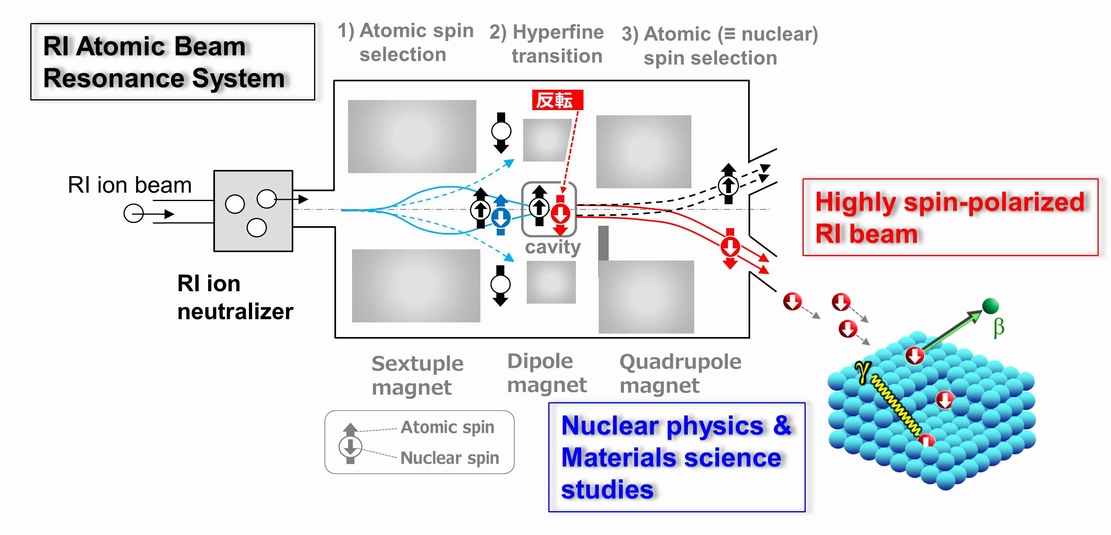| Program B03 | Highly spin-polarized RI beams and the application to nuclear and condensed matter physics |
|---|---|
| Principal Investigator | UENO, Hideki (RIKEN) |
Application of atomic nuclear spin as a tool to study
interdisciplinary researches, for example, materials-science
researches based on nuclear magnetic resonance (NMR) method is
indispensable today. A key in such researches is the production of
nuclear spin polarization. In conventional NMR methods, only 0.01%
spin polarization produced and utilized by simply applying an
external field is utilized. In contrast, muon beam technologies
enable to conduct a measurement similar to NMR through the doping of
100% spin-polarized positive muons into a sample crystal. This
technique is known as the µSR method (muon spin
resonance/relaxation/rotation method). In µSR experiments, a
detection sensitivity 11-order as high as those obtained in
conventional NMR can be realized (the sensitivity is proportional to
the square of the spin polarization), owing to the high spin
polarization and the high β-ray detection efficiency, in which
the signal is observed through a change in the β-ray angular
distribution. Because of these advantages, the µSR method has
been widely used all over the world in materials-science researches
as an already established method.
However, the µSR method has no sensitivity to a local field at
the lattice-site location in a crystal (i.e., atomic nucleus
position) and its electrical properties. The use of
radioactive-isotope (RI) probes can be expected as a method to solve
these problems. Provided that highly spin-polarized RI probes are
produced independently of their element properties and doped into a
substance as an impurity, the constituent particle of the substance
can be substituted by the same element RI probe without changing the
material structure. Accordingly, we can observe a local field
including an electrical local field at the lattice site location in a
crystal. This scheme provides a new opportunity to for
materials-science researches, but a key technology,
element-independent highly spin-polarized RI beams, has not yet been
developed. In this research, based on the idea applying the atomic
beam resonance method to short-lived RIs, we aim to realize a
"ultra-slow & highly-polarized RI beam" (in particular, highly
polarized oxygen RI beam in this project) which plays a complementary
role with µSR, and to pioneer new materials-science researches
based on the β-NMR method. Furthermore, we will conduct unique
nuclear spectroscopic research combining thus produced spin-polarized
RI beams and the astrophysics detector.
Members
| Principal Investigator | UENO, Hideki (RIKEN Cluster for Pioneering Research/RIKEN Nishina Center for Accelerator-Based Science) |
 |
|---|---|---|
| Co-Investigators | TAKAMINE, Aiko (RIKEN) | |
| YAMAZAKI, Hiroki (RIKEN) | ||
| YAMAMOTO, Ayako (Shibaura Institute of Technology) | ||
| ZHENG, Xuguang(Saga University) | ||
| Research Collaborators | IMAMURA, Kei (RIKEN) | |
| GO, Shintaro (RIKEN) | ||
| TAJIMA, Minori (RIKEN) | ||
| ABE, Takashi (RIKEN) | ||
| MUKAI, Momo (RIKEN) | ||
| YOSHIMI, Akihiro (Okayama University) | ||
| ICHIKAWA, Yuichi (Kyushu University) | ||
| SATO, Wataru (Kanazawa University) | ||
| NISHIBATA, Hiroki (Kyushu University) | ||
| WATANABE, Shin (JAXA) | ||
| KINO, Yasushi (Tohoku University) | ||
| MIYAKE, Yasuhiro (KEK-IMSS) |
Reference Materials
- Y. Ito, ..., A. Takamine et al., “First direct mass measurements of nuclides around Z = 100 with an MRTOF-MS,” Phys. Rev. Lett. 120, 152501-1–6 (April 2018), DOI: 10.1103/PhysRevLett.120.152501 .
- A. Kusoglu, … , H. Nishibata, Y. Ichikawa, H. Ueno et al., “Magnetic moment of the 13/2+ isomeric state in Cu-69: Spin alignment in the one-nucleon removal reaction,” Phys. Rev. C 93, 054313-1–6 (May 2016), DOI: 10.1103/PhysRevC.93.054313 .
- A. Yamamoto et al., “High-pressure effects revisited for the cuprate superconductor family with highest critical temperature,” Nat. Commun. 6, 8990-1–7 (December 2015), DOI: 10.1038/ncomms9990 .
- H. Ueno, “Nuclear moments and structure of unstable nuclei,” JPS Conf. Proc. 6, 010009-1–8 (June 2015), DOI: 10.7566/JPSCP.6.010009 .
- A. Takamine et al., “Hyperfine structure constant of the neutron halo nucleus Be+11,” Phys. Rev. Lett. 112, 162502-1–5 (April 2014), DOI: 10.1103/PhysRevLett.112.162502 .


